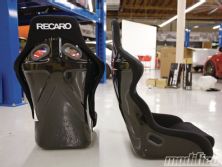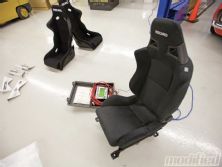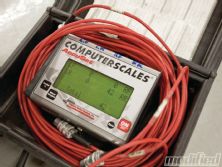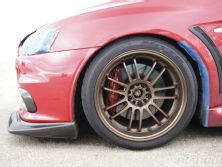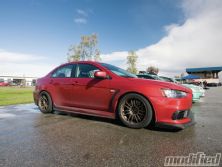 | 2008 Mitsubishi Evo - The Road To Success - Project Evo
| 2008 Mitsubishi Evo - The Road To Success - Project Evo
In my quest to dip below the 2-minute barrier at Buttonwillow Raceway Park, I had to take the plunge and change some things on the EVO that I didn’t necessarily want to. Unfortunately, after trying very hard with the previous setup but coming up 3 seconds short of my target (during my last outing, the EVO ran a 2:03.200), it was time I sacrificed just a little comfort and streetability in hopes of reaching my goal.
As much as I liked the Falken RT-651K street tires that I was running as my track setup, I needed more grip, and that meant leaving the realm of street tires and entering the R-compound world. Because the EVO is such a heavy car, it really needs all the grip you can throw at it, and the Nitto NT01 is an ideal choice. The NT01 has been around for many years now and proved itself as one of the go-to tires for track junkies and go-fast fiends. It provides tremendous amounts of grip without the accelerated wear time that would be found on full race slicks; you can easily expect to get a season’s worth of track days out of the NT01. And while they aren’t recommended to be driven on the street, you can get away with it if need be — just hope there isn’t any rain.
Go figure, it was sunny when I left the house (on the NT01s), and as soon as I was halfway to the track, a rain storm hit hard, practically flooding the highway at some points. Thank goodness for AWD, but even then there were some scary hydroplaning moments. Bottom line, keep these tires on the track and off the streets as much as possible. Thanks to the EVO’s massive wheel clearance, I was able to fit a set of 275/35R18 NT01s on my 18x10.5-inch Volk RE30 wheels with no rubbing issues to report. Before I get to my track review of the tires, there was one other aspect of the EVO that I felt I could improve without really upsetting the way it drove and performed: the seats.
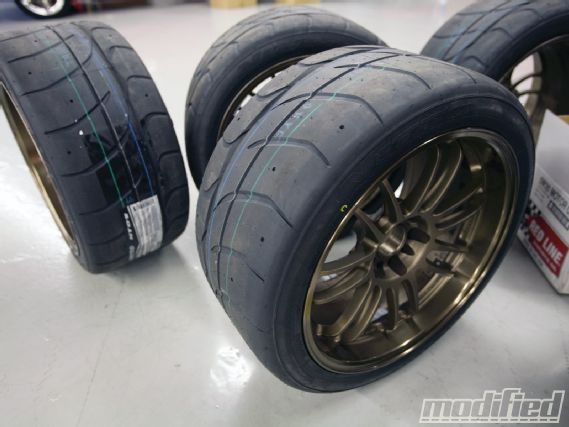 |
Nitto NT01 tires would provide the extra necessary grip needed to push the EVO harder and faster through Buttonwillow Raceway Park’s complex set of turns.
|
Nitto NT01 tires would provide the extra necessary grip needed to push the EVO harder and faster through Buttonwillow Raceway Park’s complex set of turns.
The stock Recaro seats are some of the best and most supportive on the market, but they still have compromises to keep the masses happy. The biggest downfall to the stock Recaros are how heavy they are. With built-in airbags and reclinable support, the driver side tips in at 42 lbs while the passenger side, which is equipped with an additional weight sensor, weighs in at a hefty 48 lbs. I figured I could cut the weight in half with some lightweight bucket seats. That would surely provide some benefit at the track — every pound counts!
Being that Recaro was original equipment in the EVO, I chose them for my bucket seats as well. There’s been some talk that Recaro has slowed down in the aftermarket seat business, especially in the U.S., and I’m here to tell you none of that is true. Speaking to the head director of sales and marketing, Jonathan Sieber, he quickly pointed out that Recaro is still poised and committed to aftermarket seats and continues to be a leader in that segment. It’s easy to believe that statement when you see the quality and craftsmanship that goes into one of Recaro’s bucket seats, which, by the way, are all SFI-certified and FIA-approved (meaning you can use them in any sanctioning race series).
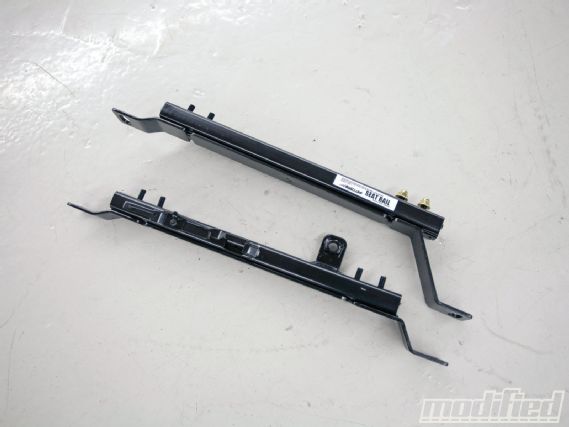 |
Buddy Club Racing Spec low side rails are the perfect solution for a bolt-in rail that allows for a low seating position while being adjustable.
|
Buddy Club Racing Spec low side rails are the perfect solution for a bolt-in rail that allows for a low seating position while being adjustable.
Although I would have loved to buy some ultra-lightweight (8.8 lbs) carbon-Kevlar-backed Recaro Profi SPA seats, the price was a bit too steep. Instead, a much more affordable and almost as light (14.3 lbs) alternative is the standard Profi bucket seat. The Profi offers purpose-built shoulder and lateral support that ensures both your upper and lower body are snug and free of any considerable movements. It has a fiberglass backing that’s rigid and conforms to most slender body types. My waist size is a 33 and the Profi is very close-fitting for me. If you’re any bigger, I suggest stepping up to the Profi XL, which is 35mm or 50mm wider than the regular seat. The Profi also accepts 4-, 5-, and 6-point harness setups.
Speaking of, I dug up an old Cobra 4-point harness I had laying around and fit it to my AMS harness bar and put some eyebolt anchors into the stock seatbelt and seat mounting locations to fasten the lower belts, but that was after I installed Buddy Club’s Racing Spec seat rails. These have built-in sliders and fit the stock seat mounting positions, while the side brackets offer a wide range of positioning to get your seat really low. They’re a no-nonsense solution to mounting a bucket seat easily and quickly.
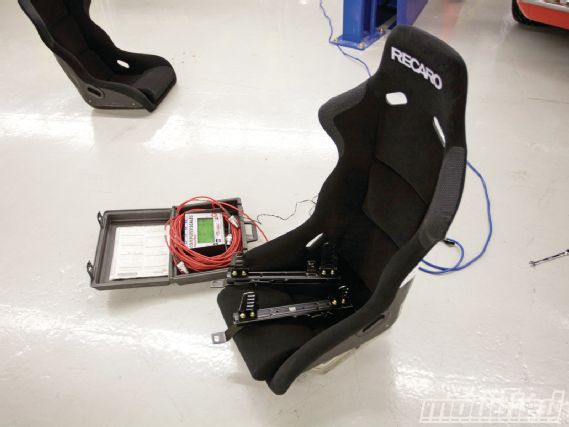 |
In comparison, the Recaro Profi seat and Buddy Club rails weigh in at 24 lbs, nearly half the weight of the stock seats.
|
In comparison, the Recaro Profi seat and Buddy Club rails weigh in at 24 lbs, nearly half the weight of the stock seats.
During installation, I weighed everything to see exactly how much weight I had saved by switching over to the Profi seats and Buddy Club seat rails. Combined, the rails and seat weighed 24 lbs apiece, totaling 48 lbs. That’s the same weight of the passenger-side OEM Recaro seat, meaning I had saved a hefty 42 lbs with the Recaro Profi buckets. Not only that, but I had lowered the center of gravity as well.
The only drawback to installing aftermarket seats in the EVO is that you have to deal with the airbag light. There are work-arounds where you wire in resistors to fool the computer into thinking the side airbags are there, but I already have a TPMS warning light on, so having the airbag light illuminated was no big deal.
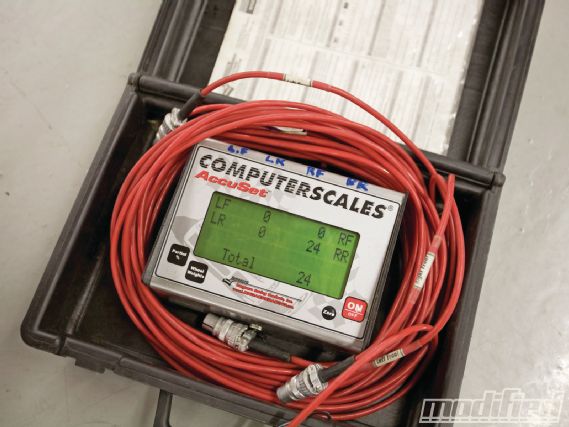 |
2008 Mitsubishi Evo - The Road To Success - Project Evo
|
2008 Mitsubishi Evo - The Road To Success - Project Evo
After a rather eventful and rain-stricken drive up to Buttonwillow, I was ready to attack the course in hopes of hitting that 2-minute target time. Track days can be either extremely fun and exciting or frustrating and annoying, depending on who’s running the show. I’ve experienced both, and that’s why I always stick to running with Speed Ventures, which puts on professional, timely, well-mannered track events. Its guidelines and groupings ensure that you’re comfortable and safe at all times, but, more importantly for me, you have properly matched cars in run groups so you can drive at the limit and not run into too much traffic. I needed to get some clean laps to see what the new setup could do, and running in the advanced group with a lower car count ensured that opportunity. There’s nothing more frustrating than getting caught up in traffic and having it affect your lap times.
Since it rained the night before, the track was damp in the morning and I knew I wouldn’t have a chance to get some clean laps in, but the slick surface provided a rare opportunity to see how the NT01s would perform. Surprisingly, they proved up to the challenge. As long as I wasn’t too aggressive going into a corner, the NT01s provided enough traction to maneuver on the wet pavement. I also got to experience the AYC and AWD in full effect and was once again blown away at how well this car communicates and provides feedback to the driver. I could hang the back end out almost at full opposite lock, and by playing with the throttle, the car would go where I pointed it, composed and calm.
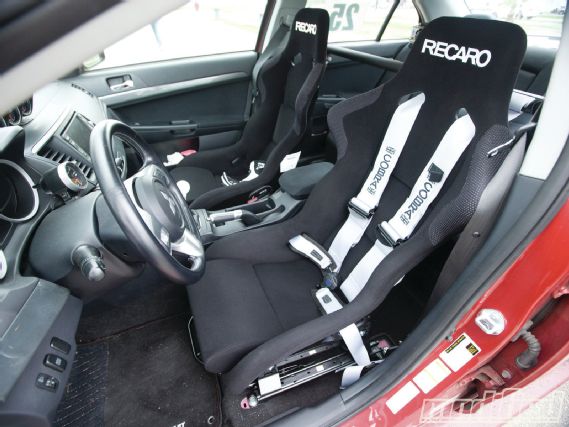 |
With the Recaros bolted down and the Cobra harness buttoned up, the EVO was not only 42 lbs lighter than before but it was ready to attack the track at a more aggressive pace.
|
With the Recaros bolted down and the Cobra harness buttoned up, the EVO was not only 42 lbs lighter than before but it was ready to attack the track at a more aggressive pace.
In the afternoon, the sun finally broke through the clouds just long enough for me to get some proper runs in. The temperature was in the low 60s (Fahrenheit), which meant the engine had some cold air to feed on. I had a good feeling about the next few laps — it was time to crank it up to 11.
I drove the wheels off the EVO for the next hour. The NT01s provided substantially more grip than the 651Ks that I had on previously, so I was able to carry more speed into and out of corners, which gave me some great runs down the few straights at Buttonwillow. Thanks to the upgraded Whiteline rear sway bar that I had recently added, the EVO rotated much better than before, producing the slightest oversteer.
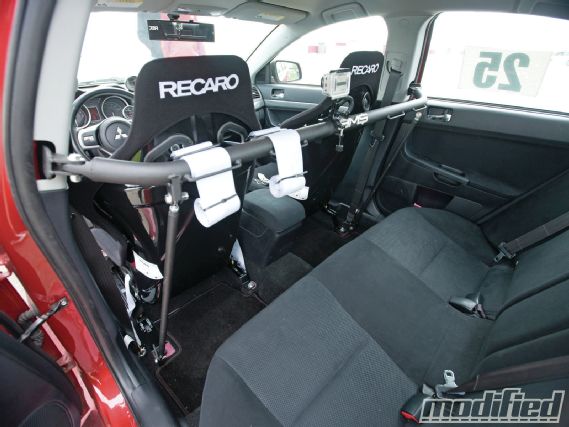 |
2008 Mitsubishi Evo - The Road To Success - Project Evo
|
2008 Mitsubishi Evo - The Road To Success - Project Evo
The Recaro Profi seat and Cobra harness were also doing their jobs; when you feel secure and snug in a seat, you’re able to drive harder and faster than when you’re being slung back and forth like you would in a stock seat. If you don’t think it works, try it and you’ll be very surprised. Remember, a large part of driving on the track is being able to push yourself to the limits, both physically and mentally. If you don’t feel safe in a 100-mph corner, then odds are you won’t try to go faster.
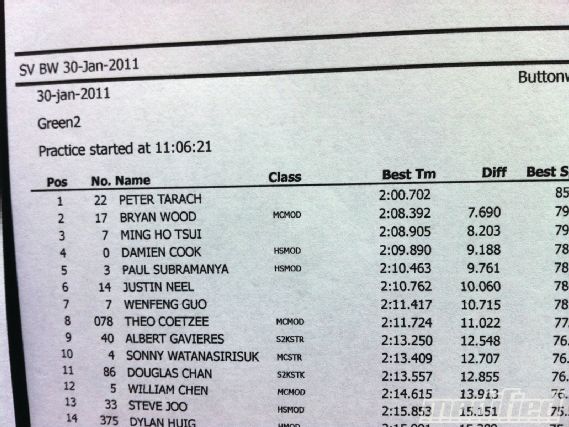 |
A time of 2:00.702 was the best lap of the day for the EVO X, not only setting a personal best but breaking into the elusive 2-minute-flat marker.
|
A time of 2:00.702 was the best lap of the day for the EVO X, not only setting a personal best but breaking into the elusive 2-minute-flat marker.
And faster I went. I reached my goal of running a 2-minute-flat with a best time of 2:00.700. That’s 2.5 seconds faster than my previous time by changing tires, seats and the rear sway bar. I’ll pat myself on the back for some of the best driving that I’ve done in a long time; I have to hand it to the EVO, it took the beating like a champ with no hiccups or problems to report of.
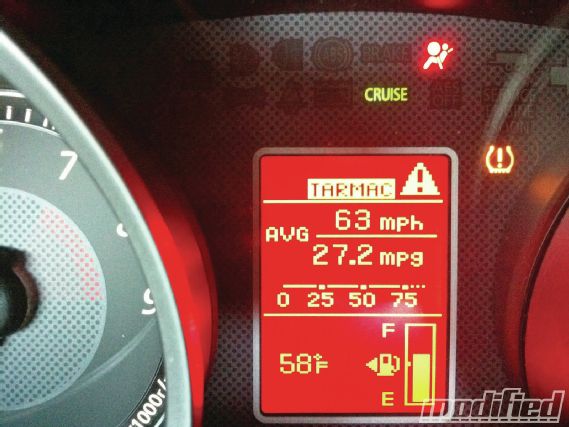 |
Further proof that the EVO is such a great dual-purpose car: 27.2 mpg (highway) after a long day at the track. Can’t beat that!
|
Further proof that the EVO is such a great dual-purpose car: 27.2 mpg (highway) after a long day at the track. Can’t beat that!
To top it all off, the EVO managed to get a staggering 27.2 mpg (highway) on the drive home. Albeit I had to cruise at 65 mph because associate editor Nate Hassler popped the head gasket in his Civic and we couldn’t go any faster. It goes to show, though, the EVO is a true dual-purpose automobile. It can run a 2-minute flat at Buttonwillow and still get 27 mpg cruising home. That’s something hard to find these days. Props to Mitsubishi.
Clutch Pedal Woes
During my track outing, I experienced a mushy clutch pedal at times, and after researching the issue, I learned that the EVO X uses a plastic clutch master cylinder and it is known to fail, especially with an upgraded clutch. I don’t have that, but to be better safe than sorry, I ordered a Magnus Motorsports Clutch Master Cylinder Upgrade that is engineered to replace the entire OEM EVO X setup with an EVO VIII/IX master cylinder that’s much stronger and more durable. Magnus has done all the hard legwork and designed a backing plate, along with an adapter that makes this upgrade a simple bolt-on solution. It also allows you to adjust your clutch pedal height. All in all, this is a worthy upgrade for anyone who’s looking to beat on an EVO.
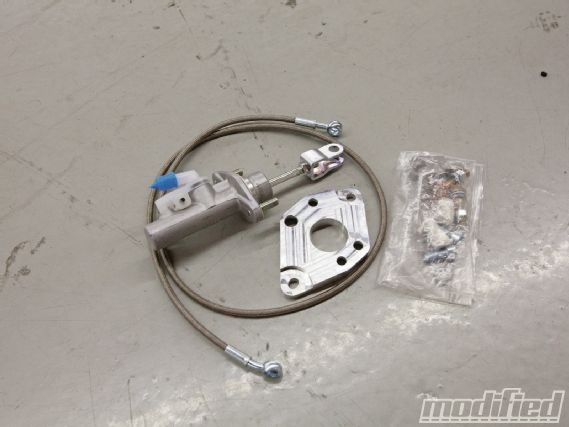 |
2008 Mitsubishi Evo - The Road To Success - Project Evo
|
2008 Mitsubishi Evo - The Road To Success - Project Evo
Sourcebox
Recaro
Profi Bucket Seats
recaro.com
Nitto
NT01 275/35R18 Tires
nitto.com
Buddy Club
Racing Spec Seat Rails
buddyclub.com
Speed Ventures
Racing Spec Seat Rails
speedventures.com
Magnus Motorsports
Master Cylinder Upgrade
magnusmotorsports.com

